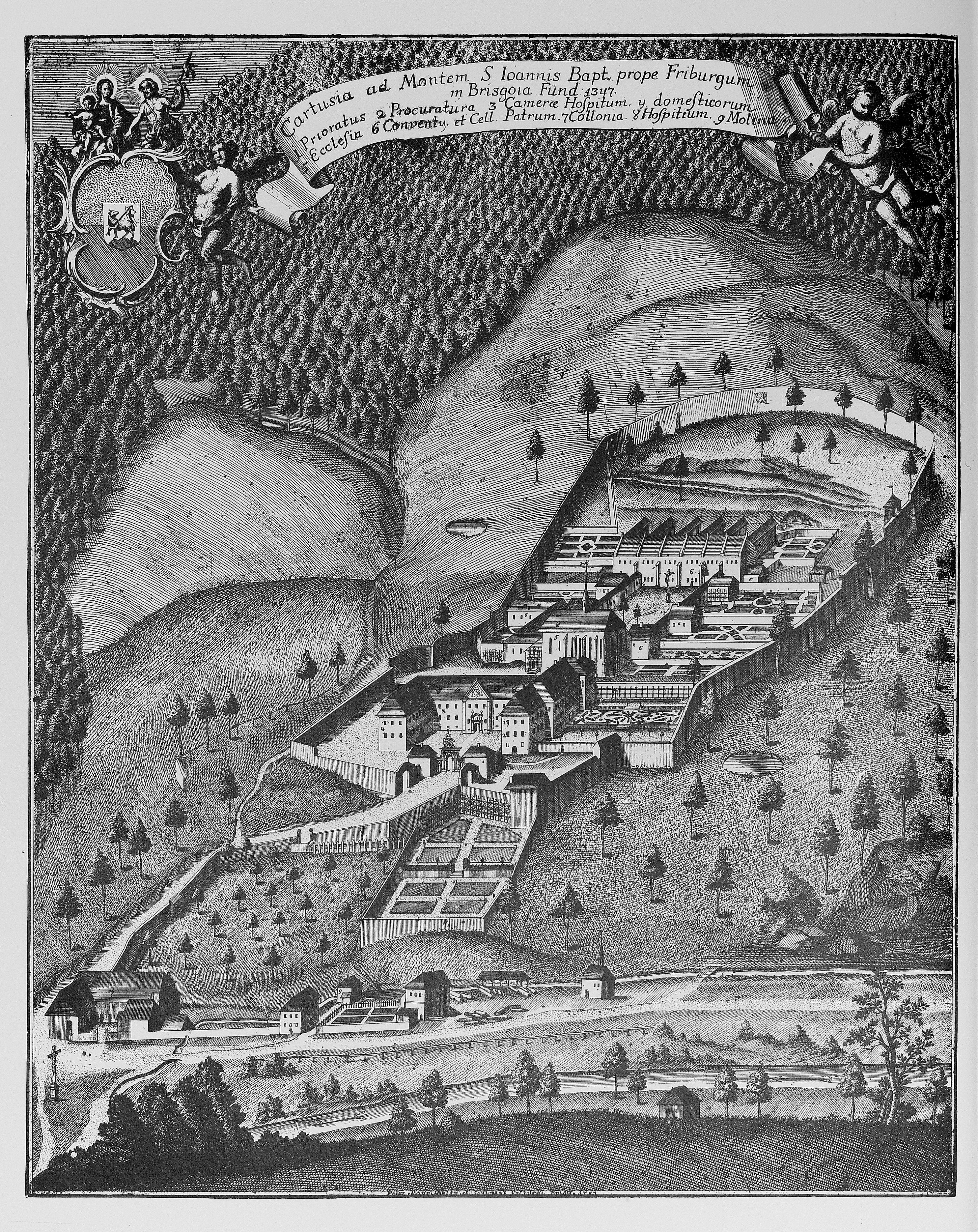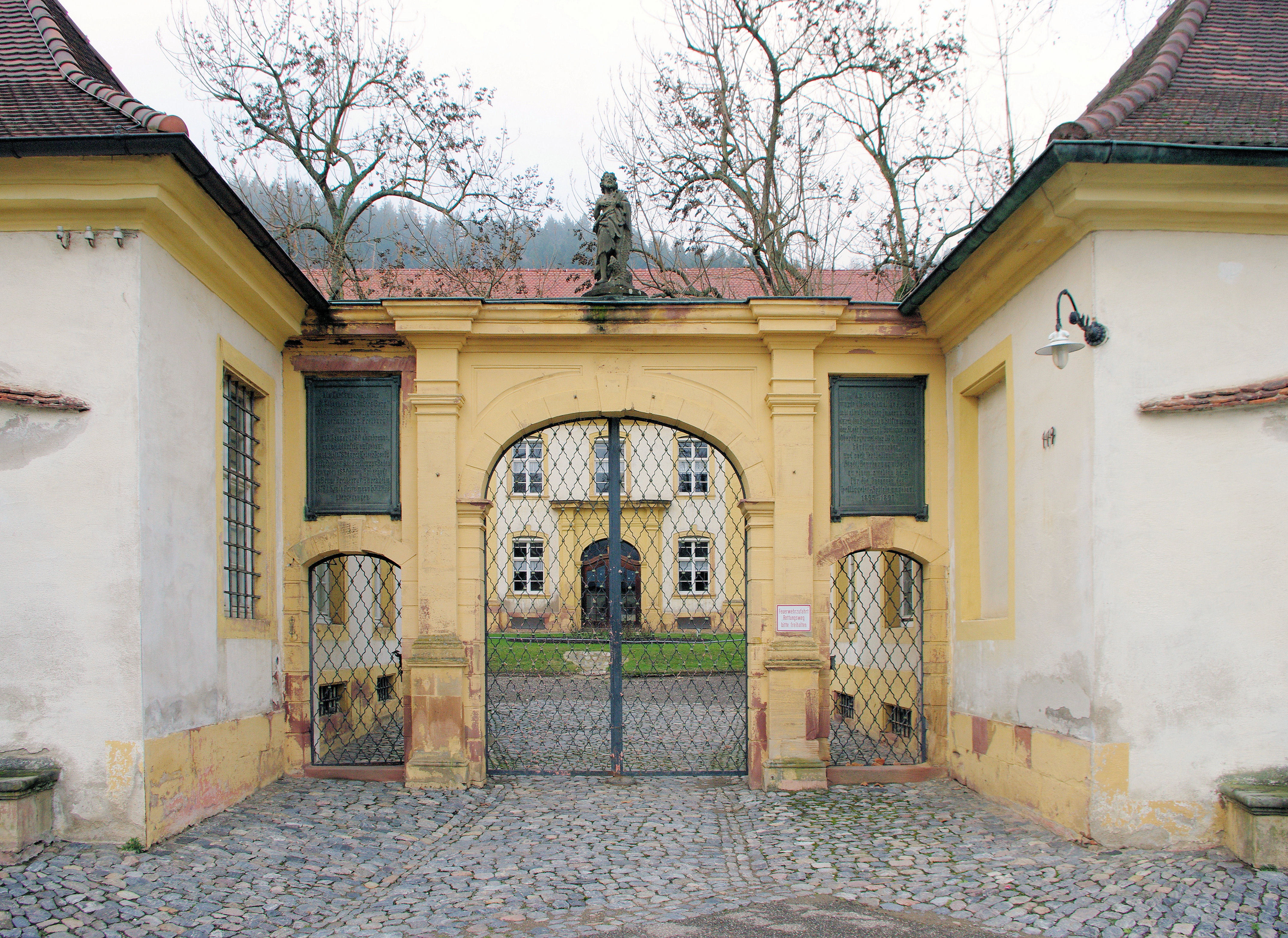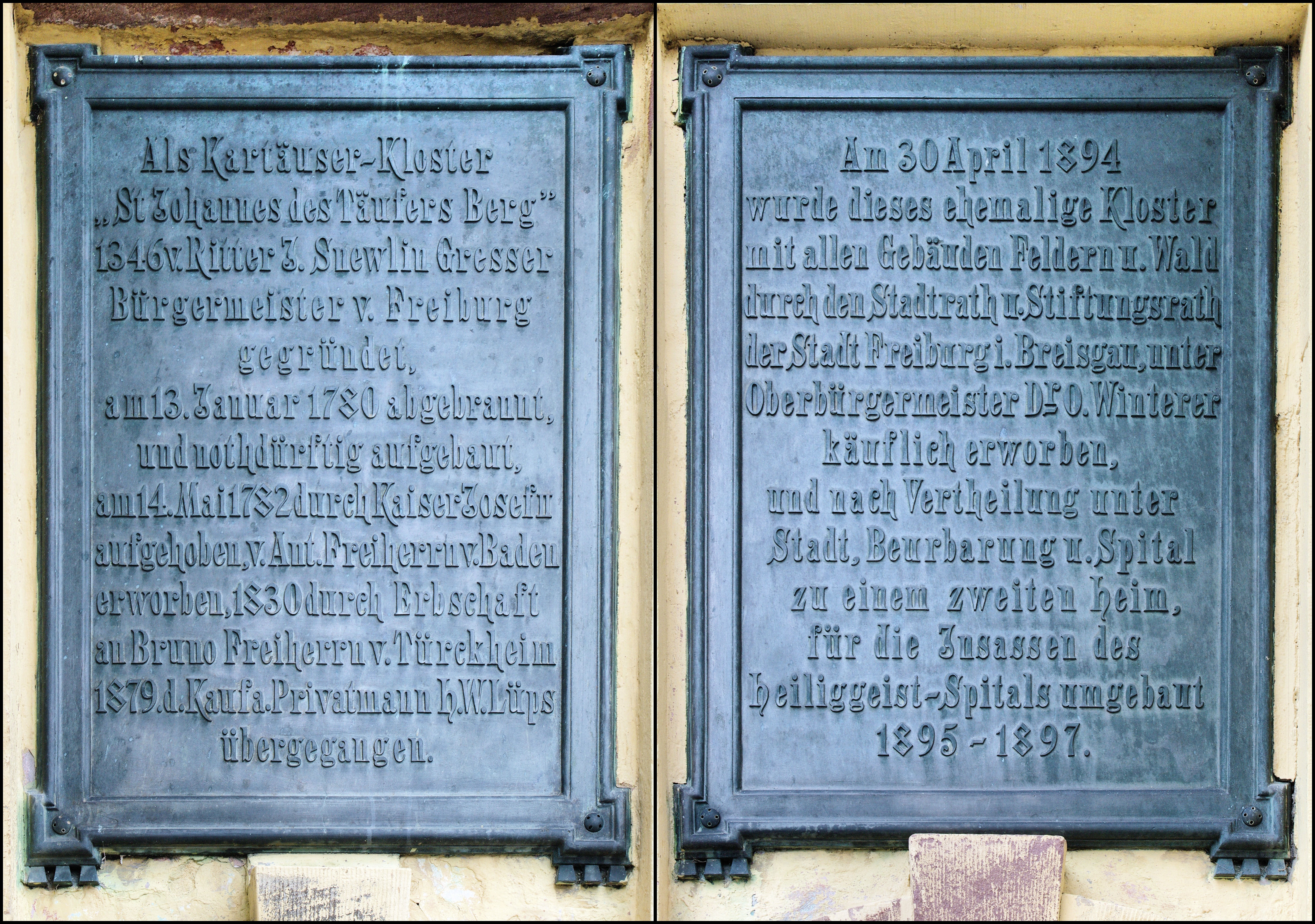Freiburg Charterhouse on:
[Wikipedia]
[Google]
[Amazon]
 Freiburg Charterhouse (''Kartause Freiburg'') is a former
Freiburg Charterhouse (''Kartause Freiburg'') is a former


 Freiburg Charterhouse was founded in 1345 or 1346 by Johannes Schnewlin (Snewelin, Snewlin), knight, ''
Freiburg Charterhouse was founded in 1345 or 1346 by Johannes Schnewlin (Snewelin, Snewlin), knight, ''UWC Robert Bosch College in Freiburg

Zum Buchbesitz der Kartause ''Mons Sancti Johannis'' bei Freiburg im Breisgau
'. In: ''Bücher, Bibliotheken und Schriften der Kartäuser''. Tübingen 2001 {{University of Freiburg Monasteries in Baden-Württemberg Carthusian monasteries in Germany 1340s establishments in the Holy Roman Empire 1782 disestablishments in Europe Buildings and structures in Freiburg im Breisgau United World Colleges 1345 establishments in Europe
 Freiburg Charterhouse (''Kartause Freiburg'') is a former
Freiburg Charterhouse (''Kartause Freiburg'') is a former Carthusian
The Carthusians, also known as the Order of Carthusians ( la, Ordo Cartusiensis), are a Latin enclosed religious order of the Catholic Church. The order was founded by Bruno of Cologne in 1084 and includes both monks and nuns. The order has its ...
monastery, or charterhouse, in Freiburg im Breisgau
Freiburg im Breisgau (; abbreviated as Freiburg i. Br. or Freiburg i. B.; Low Alemannic German, Low Alemannic: ''Friburg im Brisgau''), commonly referred to as Freiburg, is an independent city in Baden-Württemberg, Germany. With a population o ...
, Baden-Württemberg
Baden-Württemberg (; ), commonly shortened to BW or BaWü, is a German state () in Southwest Germany, east of the Rhine, which forms the southern part of Germany's western border with France. With more than 11.07 million inhabitants across a ...
, Germany
Germany,, officially the Federal Republic of Germany, is a country in Central Europe. It is the second most populous country in Europe after Russia, and the most populous member state of the European Union. Germany is situated betwe ...
.
History


 Freiburg Charterhouse was founded in 1345 or 1346 by Johannes Schnewlin (Snewelin, Snewlin), knight, ''
Freiburg Charterhouse was founded in 1345 or 1346 by Johannes Schnewlin (Snewelin, Snewlin), knight, ''Bürgermeister
Burgomaster (alternatively spelled burgermeister, literally "master of the town, master of the borough, master of the fortress, master of the citizens") is the English form of various terms in or derived from Germanic languages for the chief m ...
'' of Freiburg. It was dedicated to Saint John the Baptist
John the Baptist or , , or , ;Wetterau, Bruce. ''World history''. New York: Henry Holt and Company. 1994. syc, ܝܘܿܚܲܢܵܢ ܡܲܥܡܕ݂ܵܢܵܐ, Yoḥanān Maʿmḏānā; he, יוחנן המטביל, Yohanān HaMatbil; la, Ioannes Bapti ...
, in honour of the Grande Chartreuse
Grande Chartreuse () is the head monastery of the Carthusian religious order. It is located in the Chartreuse Mountains, north of the city of Grenoble, in the commune of Saint-Pierre-de-Chartreuse (Isère), France.
History
Originally, the ch ...
near Grenoble, and was known as ''Sankt Johannisberg'' or ''St. Johannes des Täufers Berg'' ("St John's Mount" or the "Mount of St. John the Baptist"). It was to begin with a very modest establishment of only two monks' cells, increased on the death of the founder in 1347 to five. The original endowment consisted of a piece of land on the Mussbach below Sankt Ottilien; later endowments made it possible to increase the number of cells to twelve.
In the early 16th century, the premises were extended by the addition of the refectory and the church, which was constructed in the Late Gothic style with ribbed vaulting and flying buttresses. It featured magnificent stained glass windows to designs by the Swabia
Swabia ; german: Schwaben , colloquially ''Schwabenland'' or ''Ländle''; archaic English also Suabia or Svebia is a cultural, historic and linguistic region in southwestern Germany.
The name is ultimately derived from the medieval Duchy of ...
n painter Hans Baldung Grien.
At its height the charterhouse maintained close contact with the University of Freiburg
The University of Freiburg (colloquially german: Uni Freiburg), officially the Albert Ludwig University of Freiburg (german: Albert-Ludwigs-Universität Freiburg), is a public university, public research university located in Freiburg im Breisg ...
. From 1502 to 1525 the prior was Gregor Reisch
Gregor Reisch (c. 1467 - 9 May 1525) was a German Carthusian monk and humanist scholar. He is best known for his compilation ''Margarita Philosophica'', one of the earliest printed encyclopedias of general knowledge.
Life
Reisch was born at Balin ...
, a significant representative of late Scholasticism
Scholasticism was a medieval school of philosophy that employed a critical organic method of philosophical analysis predicated upon the Aristotelian 10 Categories. Christian scholasticism emerged within the monastic schools that translate ...
and a professor at the university. The monastery supported impoverished students and in its turn received donations and novices from the circles round the university.
The monastery gradually built up a significant library, particularly through its contact with the university, mainly through the gifts of new entrants to the monastery, and also through legacies from university staff and local clergy. For example, in 1537 the monastery inherited the library (consisting of c. 390 books) and the estate of Otmar Nachtgall.
The Thirty Years' War
The Thirty Years' War was one of the longest and most destructive conflicts in European history
The history of Europe is traditionally divided into four time periods: prehistoric Europe (prior to about 800 BC), classical antiquity (80 ...
and the ravages of the Swedish
Swedish or ' may refer to:
Anything from or related to Sweden, a country in Northern Europe. Or, specifically:
* Swedish language, a North Germanic language spoken primarily in Sweden and Finland
** Swedish alphabet, the official alphabet used by ...
army caused a huge disruption. Like many other Carthusians the monks of Freiburg took refuge in Ittingen Charterhouse in Switzerland
). Swiss law does not designate a ''capital'' as such, but the federal parliament and government are installed in Bern, while other federal institutions, such as the federal courts, are in other cities (Bellinzona, Lausanne, Luzern, Neuchâtel ...
. Between 1753 and 1756 the buildings were enlarged by the addition, in front of the medieval cell range, of a grand Baroque
The Baroque (, ; ) is a style of architecture, music, dance, painting, sculpture, poetry, and other arts that flourished in Europe from the early 17th century until the 1750s. In the territories of the Spanish and Portuguese empires including t ...
courtyard of three wings for the accommodation of prelates, plus a guest wing. The prior's attempt to attain the rank of prelate caused an internal revolt, which was put aside in 1781, after the monastery had suffered a serious fire the previous year.
Emperor Joseph II commanded the dissolution of all Carthusian monasteries, including Freiburg, within five months of the decree dated 13 February 1782. Its buildings and lands became the property of the state and were sold to the Baron von Baden in 1783. The library was dispersed; only a few incunabula
In the history of printing, an incunable or incunabulum (plural incunables or incunabula, respectively), is a book, pamphlet, or broadside that was printed in the earliest stages of printing in Europe, up to the year 1500. Incunabula were pro ...
can now be traced, in the library of Freiburg University.
After the dissolution the buildings were converted for a country house of the nobility, with the prior's lodging as the main residence. The cloisters with the monks' cells were demolished to make way for a park, but the church was kept. The precious stained glass windows were sold off to various villages.
The charitable foundation of Freiburg acquired the property in 1894 and between 1895 and 1897 converted it into a nursing home, with places for 200 almspeople, as an extension to the Hospital of the Holy Ghost (''Heilig-Geist-Spital''). In 1897 Heinrich Hansjakob, the priest of Sankt Martin, was granted three rooms, by the intervention of the ''Bürgermeister'' and chairman of the charity committee, Otto Winterer. These rooms have been kept until today as a memorial.
In 1969, the nursing home moved to the newly built ''St. John's Home'' next door.
Since 2014, the building and facilities have been the home of the Robert Bosch United World College, a college of the UWC movement founded in the 1960s by Kurt Hahn.
Notes
Sources
* Kalchtaler, Peter: ''Kartause mit bewegter Geschichte, Kloster, Gutshof und Altenheim.'' In: ''Badische Zeitung'' 17 June 2005 *Mertens, Dieter:Zum Buchbesitz der Kartause ''Mons Sancti Johannis'' bei Freiburg im Breisgau
'. In: ''Bücher, Bibliotheken und Schriften der Kartäuser''. Tübingen 2001 {{University of Freiburg Monasteries in Baden-Württemberg Carthusian monasteries in Germany 1340s establishments in the Holy Roman Empire 1782 disestablishments in Europe Buildings and structures in Freiburg im Breisgau United World Colleges 1345 establishments in Europe